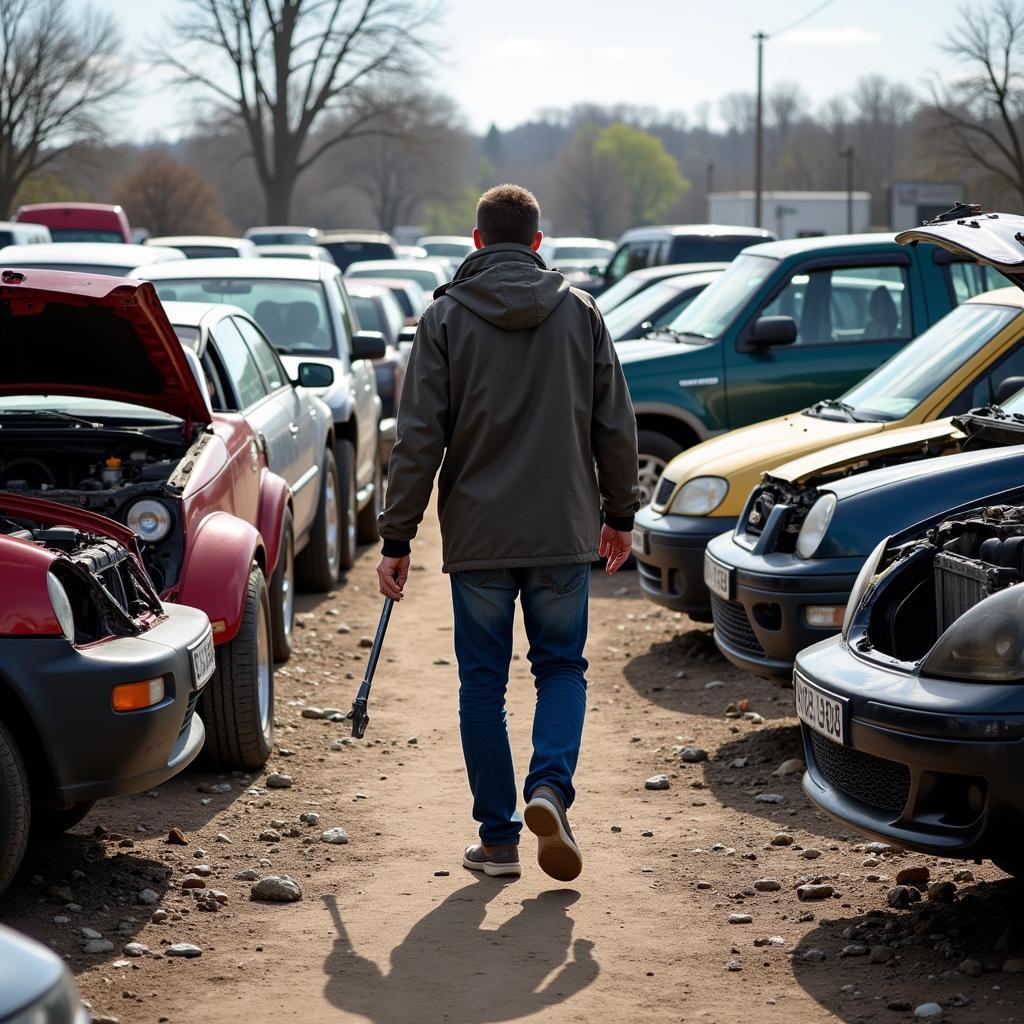Fixing a car can be an expensive endeavor, especially when relying on brand-new parts from dealerships. However, there’s a budget-friendly alternative that can save you a significant amount of money: junkyards. Using junkyard parts to fix your car might seem daunting at first, but with a little guidance and know-how, it can be a rewarding and cost-effective solution. This comprehensive guide will walk you through the process of finding, evaluating, and utilizing junkyard parts to get your car back on the road.
 Searching for car parts in a junkyard
Searching for car parts in a junkyard
Why Choose Junkyard Parts?
The most obvious advantage of using junkyard parts is the cost savings. Used parts can be significantly cheaper than their brand-new counterparts, sometimes by as much as 50% or more. This is especially beneficial for older car models where new parts might be scarce or exorbitantly priced. Moreover, junkyards often have a wider selection of parts available, including those for discontinued models that might be impossible to find elsewhere.
Finding the Right Junkyard
Not all junkyards are created equal. Some specialize in certain car makes or models, while others might have a broader but less specialized inventory. Before heading out, it’s wise to call ahead and inquire about their inventory. Additionally, consider these factors:
- Organization: A well-organized junkyard will make your search much easier.
- Cleanliness: While junkyards aren’t known for their pristine conditions, a cleaner environment often indicates better-maintained parts.
- Customer service: Friendly and helpful staff can make your junkyard experience more pleasant and productive.
 Removing a car door for reuse
Removing a car door for reuse
Evaluating Junkyard Parts
Once you’ve located the part you need, it’s crucial to inspect it thoroughly before purchasing. Look for signs of wear and tear, rust, or damage. Keep in mind that while some wear is expected, significant damage could indicate a shorter lifespan for the part. If possible, try to test the part before buying it. For example, if you’re getting an alternator, ask if you can test it to ensure it’s functioning correctly.
Tools for the Job
Having the right tools can make your junkyard adventure smoother. Essential tools include:
- Socket set and wrenches: For removing bolts and nuts.
- Screwdrivers: In various sizes and types (Phillips, flathead).
- Pliers: For gripping and cutting.
- Hammer: For gentle persuasion when needed.
- Gloves and safety glasses: Protect yourself from sharp edges and debris.
- Container for parts: Keep your salvaged treasures organized.
 Inspecting a car engine in a junkyard
Inspecting a car engine in a junkyard
Tips for a Successful Junkyard Trip
- Dress appropriately: Wear old clothes that you don’t mind getting dirty, and closed-toe shoes to protect your feet.
- Bring your own tools: Junkyards might have some tools available, but it’s always best to be prepared.
- Take your time: Don’t rush the process. Carefully inspect each part before removing it.
- Negotiate prices: Junkyard prices are often negotiable, so don’t be afraid to haggle a bit.
- Ask for help: If you’re struggling to find or remove a part, don’t hesitate to ask the staff for assistance.
Is It Worth Fixing a Car With Junkyard Parts?
Using junkyard parts to fix your car can be a great way to save money and extend the life of your vehicle. However, it’s essential to weigh the pros and cons. If you’re comfortable with basic car repair and enjoy a good DIY project, then junkyard scavenging might be the perfect solution. However, if you’re not confident in your mechanical skills, it’s best to leave it to the professionals.
“Junkyard parts can be a real lifesaver,” says veteran mechanic John Smith. “I’ve seen countless customers save hundreds, even thousands, of dollars by opting for used parts. Just remember to inspect everything carefully and don’t be afraid to ask questions.”
Conclusion
Fixing A Car Up Using Junkyard parts can be a rewarding experience, both for your wallet and your sense of accomplishment. By following the tips and advice outlined in this guide, you can navigate the world of junkyards with confidence and find the parts you need to breathe new life into your vehicle.
Need help with a car repair? Contact AutoTipPro today at +1 (641) 206-8880 or visit our office at 500 N St Mary’s St, San Antonio, TX 78205, United States.
FAQs
1. Are junkyard parts safe?
Junkyard parts can be just as safe as new ones, provided they are inspected thoroughly and tested before installation.
2. Can I return a junkyard part if it doesn’t work?
Return policies vary between junkyards, so it’s crucial to inquire about their policy before purchasing.
3. What types of parts can I find in a junkyard?
You can find a wide range of parts, from engines and transmissions to body panels and interior components.
4. How do I know if a junkyard part will fit my car?
It’s essential to know the year, make, and model of your car and to match it with the donor vehicle at the junkyard. Online resources and the junkyard staff can also assist with compatibility checks.
5. Are there any warranties on junkyard parts?
Warranties on junkyard parts are rare but some junkyards might offer limited warranties on certain parts. Always ask about their warranty policy before purchasing.






Leave a Reply